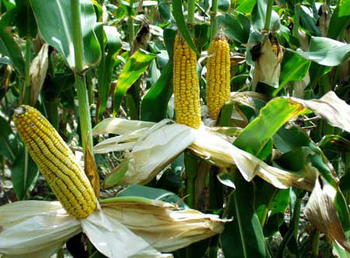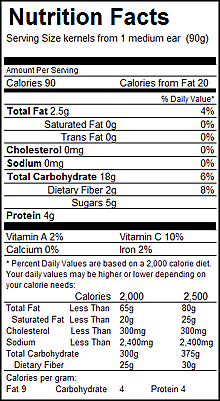Contents:
Common Names | Parts Usually Used | Plant(s) & Culture | Where Found | Medicinal Properties | Biochemical Information
Legends, Myths and Stories | Uses | Formulas or Dosages | Nutrient Content | How Sold | Bibliography
Scientific Names

- Stigmata maydis L.
- Indian Corn
- Zea mays
- Gramineae
- Grass family
Common Names
- Corn
- Indian corn
- Jugnog
- Maize
- Maize jagnog
- Sea mays
- Turkey corn
- Turkish corn
- Yu-shu-shu
Parts Usually Used
Stylus, fresh or dried flower pistils
Back to Top
Description of Plant(s) and Culture
Too well known to describe. No American vegetable has gained more importance in the diets of the world’s population than corn. A tea made from corn silk, consisting of the stigmas of the flowers, has been valued as a diuretic.
Back to Top
Where Found
Cultivated throughout America.
Back to Top
Medicinal Properties
Diuretic, lithotriptic, cholagogue, anodyne, demulcent, alterative, stimulant
Back to Top
Biochemical Information
Alkaloids, ascorbic acid, cryptoxanthin, fluorine, malic acid, oxalic acid, palmitic acid, pantothenic acid, resin, saponins, silicon, sitotsterol, stigmasterol, tartaric acid, and vitamin K.
Back to Top
Legends, Myths and Stories
The common Indian corn is generally believed to have originated in the New World that would become the United States, where it was cultivated before Christopher Columbus discovered America. Columbus took it to Spain and many thought it was brought from Asia and it was frequently known as Turkey corn, or Turkey wheat. The active principle is maizenic acid.
Native Americans used corn silk as a filler with tobacco or with August flowers, or crushed Cubeb berries.
Before Columbus indian corn was unknown in the Old World. Grown on a wide scale by the Indians of the Americas, corn, as the sustainer of life, provided a major symbol in the rituals and mythologies of many tribes. One of the best known myths of the origin of corn is the one recounted in Longfellow’s poem Hiawatha. Longfellow’s source was a contemporary account written by a United States government agent, Henry Schoolcraft, who had married an Indian girl of the Ojibwa tribe from the Great Lakes region. According to Schoolcraft’s version of the myth; the Ojibwas myth has as its protagonist an Indian youth named Wunzh, who had reached the proper age to undertake a ceremony of ritual fasting. According to the custom of his tribe, he fasted for 7 days alone in a little hut in the forest to receive communication from his guardian spirit. During his fast a handsome young god wearing green and yellow garments and a plumed, feathered headdress came to him out of the sky. The god told Wunzh that he had information for him that would be of great benefit to his tribe, but that Wunzh must wrestle with him first. After 3 wrestling matches on 3 separate days, the god declared himself seduced and gave Wunzh instructions. He told him that they would wrestle again on the following day and that the match would result in the god’s death. He directed Wunzh to bury him and to water and cultivate the burial spot at certain intervals so that a corn plant would grow up there. The god told Wunzh how to harvest and cook the corn and described the process of growing it again from the kernels. Naturally, all these things came to pass, and the tribe had a great feast of celebration at their first corn harvest.
The corn harvest also provided a central focus for the religious ceremonies of the Aztecs, Incas, and Mayas, whose high levels of civilization were made possible by their well-developed systems of agriculture, with corn as the major crop. The Aztecs held a yearly pre-harvest corn festival in which a beautiful young girl representing the corn goddess was sacrificed in an elaborate ritual lasting several days.
Back to Top
Uses
Aids the kidneys, bladder, and small intestines. Take for hypertension, edema, urinary tract dysfunction and stones, gonorrhea, gout, rheumatism, bed-wetting, jaundice, and painful urination caused by the prostate gland. Acts as a diuretic. Also indicated in dropsy and heart trouble.
Seed oil (corn oil) recommended as a health food for arteriosclerosis and high cholesterol.
Back to Top
Formulas or Dosages
Infusion: steep 2 oz. of the herb in 1 pint of boiling water and drink several wineglassfuls a day.
Back to Top
Nutrient Content
Fats, potassium, magnesium, niacin, protein and vitamins A, B6 and K

How Sold
Capsules, tea
Back to Top
Bibliography
![]() Back to Eden
Back to Eden, by Jethro Kloss; Back to Eden Publishing Co., Loma Linda, CA 92354, Original copyright 1939, revised edition 1994
 Old Ways Rediscovered
Old Ways Rediscovered, by Clarence Meyer, Meyerbooks, publisher, PO Box 427, Glenwood, Illinois 60425, published from 1954, print 1988
![]() Chinese Medicinal Herbs
Chinese Medicinal Herbs, compiled by Shih-Chen Li, Georgetown Press, San Francisco, California, 1973.
![]() Planetary Herbology
Planetary Herbology, by Michael Tierra, C.A., N.D., O.M.D., Lotus Press, PO Box 325, Twin Lakes. WI 53181., Copyright 1988, published 1992
![]() The Complete Medicinal Herbal
The Complete Medicinal Herbal, by Penelope Ody, Dorling Kindersley, Inc, 232 Madison Avenue, New York, NY 10016, First American Edition, copyright 1993
![]() Indian Uses of Native Plants
Indian Uses of Native Plants, by Edith Van Allen Murphey, Meyerbooks, publisher, PO Box 427, Glenwood, Illinois 60425, copyright 1958, print 1990
 Secrets of the Chinese Herbalists
Secrets of the Chinese Herbalists, by Richard Lucas, Parker Publishing Company, Inc., West Nyack, NY, 1987.
![]() Eastern/Central Medicinal Plants
Eastern/Central Medicinal Plants, by Steven Foster and James A. Duke., Houghton Mifflin Company, 215 Park Avenue South, New York, NY 10000
![]() Indian Herbalogy of North America
Indian Herbalogy of North America, by Alma R. Hutchens, Shambala Publications, Inc., Horticultural Hall, 300 Massachusetts Avenue, Boston, Massachusetts 02115, 1973
![]() American Folk Medicine
American Folk Medicine, by Clarence Meyer, Meyerbooks, publisher, PO Box 427, Glenwood, Illinois 60425, 1973
 Prairie Smoke
Prairie Smoke, by Melvin R. Gilmore, Minnesota Historical Society Press, St. Paul, Minnesota 55101, copyright 1987.
![]() Prescription for Nutritional Healing, Fifth Edition: A Practical A-to-Z Reference to Drug-Free Remedies Using Vitamins, Minerals, Herbs & Food Supplements
Prescription for Nutritional Healing, Fifth Edition: A Practical A-to-Z Reference to Drug-Free Remedies Using Vitamins, Minerals, Herbs & Food Supplements, by James F. Balch, M.D. and Phyllis A. Balch, C.N.C., Avery Publishing Group, Inc., Garden City Park, NY
![]() Webster’s New World Dictionary
Webster’s New World Dictionary, Third College Edition, Victoria Neufeldt, Editor in Chief, New World Dictionaries: A Division of Simon & Schuster, Inc., 15 Columbus Circle, New York, NY 10023
 How Indians Use Wild Plants for Food, Medicine & Crafts
How Indians Use Wild Plants for Food, Medicine & Crafts, by Frances Densmore, Dover Publications, Inc., 180 Varick Street, New York, NY 10014, first printed by the United States Government Printing Office, Washington, in 1928, this Dover edition 1974
![]() The Yoga of Herbs: An Ayurvedic Guide to Herbal Medicine
The Yoga of Herbs: An Ayurvedic Guide to Herbal Medicine, by Dr. David Frawley & Dr. Vasant Lad, Lotus Press, Twin Lakes, Wisconsin, Second edition, 1988.
 A Useful Guide to Herbal Health Care
A Useful Guide to Herbal Health Care, HCBL (Health Center for Better Living).,1414 Rosemary Lane, Naples, FL 34103., Special Sale Catalog, 1996
